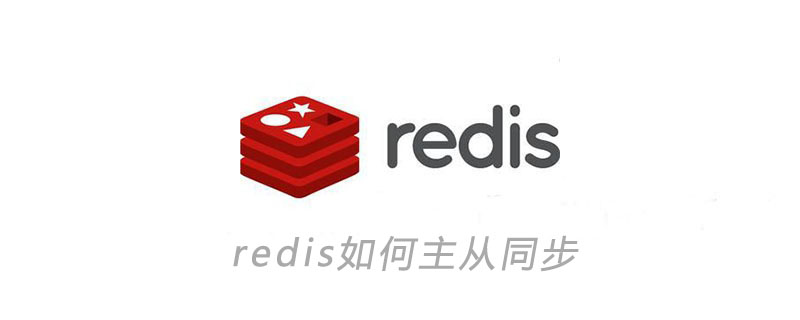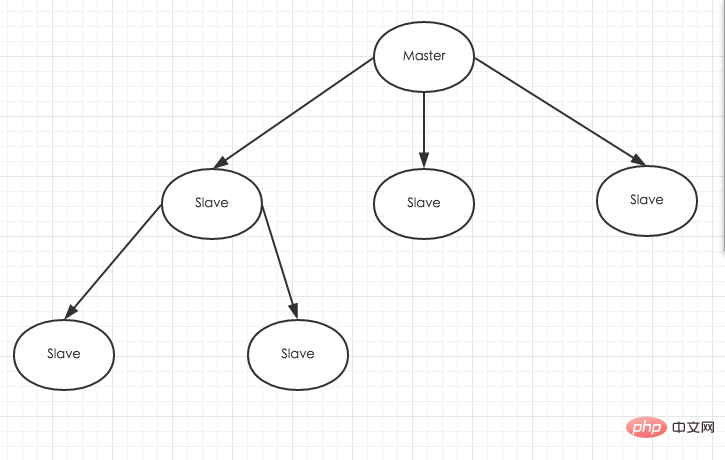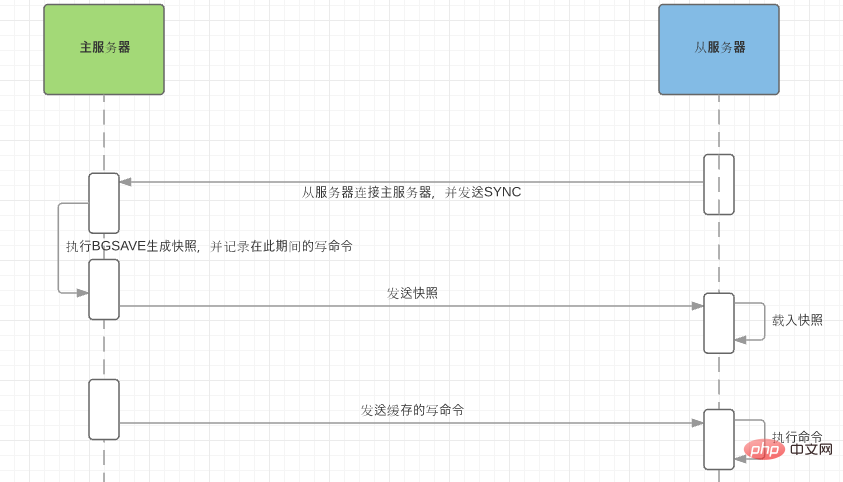How to synchronize master-slave in redis

For the same reason as MySQL master-slave replication, although Redis is very fast in reading and writing, it can also cause extremely high reading pressure. In order to share the reading pressure, Redis supports master-slave replication. The master-slave structure of Redis can use one master and multiple slaves or a cascade structure. The following figure shows the cascade structure. (Recommended learning: Redis Video Tutorial)

Redis master-slave replication can be divided into full synchronization and incremental synchronization depending on whether it is full or not.
1 Full synchronization
Redis full replication generally occurs during the Slave initialization phase. At this time, the Slave needs to transfer all the data on the Master. Make a copy of both. The specific steps are as follows:
1) The slave server connects to the main server and sends the SYNC command;
2) After the main server receives the SYNC naming, it starts executing the BGSAVE command to generate the RDB file and use the buffer record All write commands executed thereafter;
3) After the master server BGSAVE is executed, snapshot files are sent to all slave servers, and the executed write commands continue to be recorded during the sending period;
4) After receiving the snapshot file, the slave server discards all old data and loads the received snapshot;
5) After the master server snapshot is sent, it starts sending the write command in the buffer to the slave server;
6) The slave server completes loading the snapshot, starts receiving command requests, and executes write commands from the master server buffer;
 After completing the above steps, the slave server data initialization is completed For all operations, the slave server can now receive read requests from users.
After completing the above steps, the slave server data initialization is completed For all operations, the slave server can now receive read requests from users.
2 Incremental Synchronization
Redis incremental replication refers to the process of synchronizing the write operations that occur on the master server to the slave server when the Slave is initialized and starts working normally.
The process of incremental replication is mainly that every time the master server executes a write command, it will send the same write command to the slave server, and the slave server receives and executes the received write command.
3 Redis master-slave synchronization strategy
When the master-slave is just connected, full synchronization is performed; after full synchronization is completed, incremental synchronization is performed. Of course, if necessary, the slave can initiate full synchronization at any time. The redis strategy is that, no matter what, incremental synchronization will be attempted first, and if unsuccessful, the slave machine will be required to perform full synchronization.
For more Redis related technical articles, please visit the Redis Getting Started Tutorial column to learn!
The above is the detailed content of How to synchronize master-slave in redis. For more information, please follow other related articles on the PHP Chinese website!

Hot AI Tools

Undresser.AI Undress
AI-powered app for creating realistic nude photos

AI Clothes Remover
Online AI tool for removing clothes from photos.

Undress AI Tool
Undress images for free

Clothoff.io
AI clothes remover

AI Hentai Generator
Generate AI Hentai for free.

Hot Article

Hot Tools

Notepad++7.3.1
Easy-to-use and free code editor

SublimeText3 Chinese version
Chinese version, very easy to use

Zend Studio 13.0.1
Powerful PHP integrated development environment

Dreamweaver CS6
Visual web development tools

SublimeText3 Mac version
God-level code editing software (SublimeText3)

Hot Topics
 1377
1377
 52
52
 How to build the redis cluster mode
Apr 10, 2025 pm 10:15 PM
How to build the redis cluster mode
Apr 10, 2025 pm 10:15 PM
Redis cluster mode deploys Redis instances to multiple servers through sharding, improving scalability and availability. The construction steps are as follows: Create odd Redis instances with different ports; Create 3 sentinel instances, monitor Redis instances and failover; configure sentinel configuration files, add monitoring Redis instance information and failover settings; configure Redis instance configuration files, enable cluster mode and specify the cluster information file path; create nodes.conf file, containing information of each Redis instance; start the cluster, execute the create command to create a cluster and specify the number of replicas; log in to the cluster to execute the CLUSTER INFO command to verify the cluster status; make
 How to implement the underlying redis
Apr 10, 2025 pm 07:21 PM
How to implement the underlying redis
Apr 10, 2025 pm 07:21 PM
Redis uses hash tables to store data and supports data structures such as strings, lists, hash tables, collections and ordered collections. Redis persists data through snapshots (RDB) and append write-only (AOF) mechanisms. Redis uses master-slave replication to improve data availability. Redis uses a single-threaded event loop to handle connections and commands to ensure data atomicity and consistency. Redis sets the expiration time for the key and uses the lazy delete mechanism to delete the expiration key.
 How to view all keys in redis
Apr 10, 2025 pm 07:15 PM
How to view all keys in redis
Apr 10, 2025 pm 07:15 PM
To view all keys in Redis, there are three ways: use the KEYS command to return all keys that match the specified pattern; use the SCAN command to iterate over the keys and return a set of keys; use the INFO command to get the total number of keys.
 What to do if redis-server can't be found
Apr 10, 2025 pm 06:54 PM
What to do if redis-server can't be found
Apr 10, 2025 pm 06:54 PM
Steps to solve the problem that redis-server cannot find: Check the installation to make sure Redis is installed correctly; set the environment variables REDIS_HOST and REDIS_PORT; start the Redis server redis-server; check whether the server is running redis-cli ping.
 How to read redis queue
Apr 10, 2025 pm 10:12 PM
How to read redis queue
Apr 10, 2025 pm 10:12 PM
To read a queue from Redis, you need to get the queue name, read the elements using the LPOP command, and process the empty queue. The specific steps are as follows: Get the queue name: name it with the prefix of "queue:" such as "queue:my-queue". Use the LPOP command: Eject the element from the head of the queue and return its value, such as LPOP queue:my-queue. Processing empty queues: If the queue is empty, LPOP returns nil, and you can check whether the queue exists before reading the element.
 How to start the server with redis
Apr 10, 2025 pm 08:12 PM
How to start the server with redis
Apr 10, 2025 pm 08:12 PM
The steps to start a Redis server include: Install Redis according to the operating system. Start the Redis service via redis-server (Linux/macOS) or redis-server.exe (Windows). Use the redis-cli ping (Linux/macOS) or redis-cli.exe ping (Windows) command to check the service status. Use a Redis client, such as redis-cli, Python, or Node.js, to access the server.
 How to read the source code of redis
Apr 10, 2025 pm 08:27 PM
How to read the source code of redis
Apr 10, 2025 pm 08:27 PM
The best way to understand Redis source code is to go step by step: get familiar with the basics of Redis. Select a specific module or function as the starting point. Start with the entry point of the module or function and view the code line by line. View the code through the function call chain. Be familiar with the underlying data structures used by Redis. Identify the algorithm used by Redis.
 How to use redis lock
Apr 10, 2025 pm 08:39 PM
How to use redis lock
Apr 10, 2025 pm 08:39 PM
Using Redis to lock operations requires obtaining the lock through the SETNX command, and then using the EXPIRE command to set the expiration time. The specific steps are: (1) Use the SETNX command to try to set a key-value pair; (2) Use the EXPIRE command to set the expiration time for the lock; (3) Use the DEL command to delete the lock when the lock is no longer needed.




